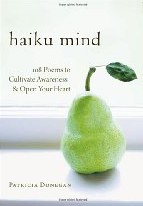
|
The Haiku Seasons: Poetry of the Natural World
by William J. Higginson. A classic introduction to Haiku. |

|
Haiku Mind: 108 Poems to Cultivate Awareness and Open Your Heart (2008)
by Patricia Donegan. 108 remarkable haiku by Japanese and Western poets, with small essays to show how such brief poems can show us how we can approach our lives. |





